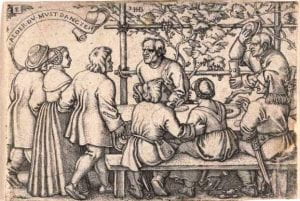The peasants’ feast by Sebald Beham
The mid-16th century, marked by the beginning of the Protestant Reformation, was a challenging time for artists working in northern Europe. In January 1525, only 7 years after Martin Luther had nailed his 95 theses onto the door of a chapel in Wittenberg and thereby setting in motion the Protestant Reformation, three artists; the brothers Sebald and Barthel Beham, and Georg Pencz were trialled before the town council of Catholic Nuremberg. For months these ‘godless painters’ were banished from the city for claiming they did not believe in baptism, Christ or transubstantiation (the belief that bread and wine would become the physical body and blood of Christ at consecration) [1.].





